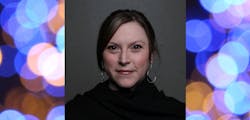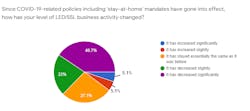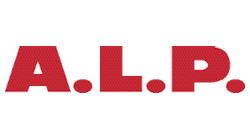As we are all finding new ways to proceed in business with the coronavirus in play, last week LEDs Magazine asked for your feedback on what impacts policies and health advisories have incurred in your daily work life in the LED and solid-state lighting (SSL) sectors. Our quick four-question poll yielded some interesting responses, some of which seem to line up with our latest news reports.
We’re sharing the chart below as a sample of the responses to the first question. Unfortunately, but not surprisingly, in question 1 nearly 41% of the poll participants indicated that their level of business has decreased significantly since policies including “stay at home” mandates have gone into effect. However, the other side of that coin is that a combined 10.2% said that their business has increased, whether slightly or significantly, and almost one third of respondents even said that business has stayed mostly the same. We might speculate that given the amount of interest in ultraviolet (UV)-based disinfection content on our website and the concentration of related company announcements on such offerings, perhaps the UV sector of the LED and SSL markets is getting a bump after all. Note that is pure speculation on my part.
Moving to question 2 about working status, the majority of respondents (nearly 70%) stated that they are working from home. Some are on a reduced work schedule (nearly 12%) and others are out of work (3.4%). We hope that is a temporary furlough in those cases. What surprised me a little was that 15.3% indicated that they are working in the office or in the field as normal. We might correlate that to product development and manufacturing operations, which made up the largest portion of responses on the question of company description, listed below in descending order:
- LED and SSL product development and manufacturing: 35.6%
- Lighting specification/design: 22%
- Other: 13.6%
- Components/materials/equipment distributor: 11.9%
- Consultative services: 11.9%
- Research/academia/lab: 5.1%
We have reported lately that some companies have resumed manufacturing operations — some in China, like Signify, as our Mark Halper learned last week. In that same linked news, Brussels-based Schréder Group stated that its Chinese and Ukraine production facilities are back online, and in recent days the company has started back up at some European plants as well.
Others have continued to operate with safety measures in place and are announcing business developments targeted directly at supporting critical healthcare efforts during this time. In Mark’s report on China operations, he also reported that A.L.P. Lighting Components is using its materials manufacturing line to fabricate face shields for healthcare workers and making them available at manufacturing cost. Kenall has released information on portable SSL combining continuous-disinfection and ambient white light, which utilizes Indigo-Clean technology to kill bacteria and is being fast-tracked for shipping to support temporary hospital facilities.
Chief editor Maury Wright recently wrote of NEMA’s efforts to have the US government acknowledge lighting manufacturing as “critical manufacturing” in order to maintain more routine operations during the global health crisis. We remain optimistic that there is opportunity for growth in the lighting markets and applications such as disinfection and other lighting for wellbeing may play a larger role in the months to come. Don’t forget to check out his feature on the State of the Industry survey that was conducted recently.
Finally, in terms of geography, the distribution of responses largely favored North America at 76.3%. Europe made up 11.9% of the participants; Asia, 8.5%; and Middle East/Africa and Central/South America both rolled in at 1.7% each. No participants identified themselves as being located in the Australasia region.

Carrie Meadows | Editor-in-Chief, LEDs Magazine
Carrie Meadows has more than 20 years of experience in the publishing and media industry. She worked with the PennWell Technology Group for more than 17 years, having been part of the editorial staff at Solid State Technology, Microlithography World, Lightwave, Portable Design, CleanRooms, Laser Focus World, and Vision Systems Design before the group was acquired by current parent company Endeavor Business Media.
Meadows has received finalist recognition for LEDs Magazine in the FOLIO Eddie Awards, and has volunteered as a judge on several B2B editorial awards committees. She received a BA in English literature from Saint Anselm College, and earned thesis honors in the college's Geisel Library. Without the patience to sit down and write a book of her own, she has gladly undertaken the role of editor for the writings of friends and family.
Meadows enjoys living in the beautiful but sometimes unpredictable four seasons of the New England region, volunteering with an animal shelter, reading (of course), and walking with friends and extended "dog family" in her spare time.







